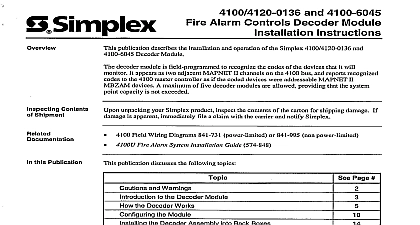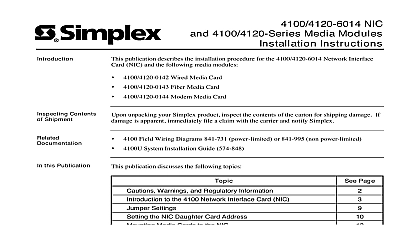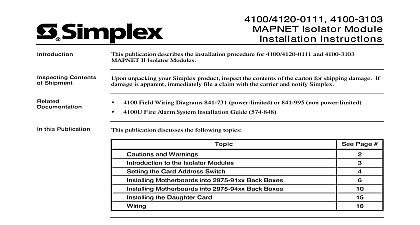Simplex 4100 4120-0136 and 4100-6045 Fire Alarm Controls Decoder Module - Installation Instructions

File Preview
Click below to download for free
Click below to download for free
File Data
| Name | simplex-4100-4120-0136-and-4100-6045-fire-alarm-controls-decoder-module-installation-instructions-5473962801.pdf |
|---|---|
| Type | |
| Size | 914.67 KB |
| Downloads |
Text Preview
4100 4120 0136 and 4100 6045 Alarm Controls Decoder Module Instructions publication describes the installation and operation of the Simplex 4100 4120 0136 and Decoder Module decoder module is field programmed to recognize the codes of the devices that it will It appears as two adjacent MAPNET II channels on the 4100 bus and reports recognized to the 4100 master controller as if the coded devices were addressable MAPNET II devices A maximum of five decoder modules are allowed providing that the system capacity is not exceeded unpacking your Simplex product inspect the contents of the carton for shipping damage If is apparent immediately file a claim with the carrier and notify Simplex Field Wiring Diagrams 841 731 power limited or 841 995 non power limited Fire Alarm System Installation Guide 574 848 Contents Shipment this Publication publication discusses the following topics Page and Warnings to the Decoder Module the Decoder Works the Module the Decoder Assembly into Back Boxes Guidelines Wiring Programming Messages 2001 Simplex Time Recorder Co Westminster MA 01441 0001 USA specifications and other information shown were current as of publication and are subject to change without notice A and Warnings HAZARD Static electricity can damage components Therefore handle as follows Ground yourself before opening or installing components use the 553 484 Static Control K0it Keep uninstalled components wrapped in anti static material at all times HAZARD Disconnect electrical power when making any internal adjustments repairs Qualified Simplex Representatives should perform servicing to the Decoder Module decoder module is a 4100 family slave card It uses six inches of mounting space and a connection to the 4100 POWER and COMM buses either by harness from an adjacent or from the P1 edge connector and an adjacent card on the bus 1 below is an illustration of the decoder module 1 4 5 6 7 and 8 SW9 3 1 Decoder Module 565 270 and LCD 1 Lights during initialization until communications are established with the 4100 Master whenever communications are lost with the Master 1 16 character 2 line LCD that is used in programming the decoder module Potentiometer is used to adjust the LCD contrast for best viewing to Table 1 for electrical and environmental requirements 1 Specifications Location Connections VDC and 2 wire RUI communications Pulse Timing Space Space mA Supervisory mA Alarm ms minimum with repetition tolerance of 25 to 5 times digit pulse maximum digit space 12.3 seconds to 120 F 0 to 49 C Non condensing 86 F 30 C on next page to the Decoder Module Continued Blocks and TB2 Connection to coded stations or relay contacts Power and RUI Connections RUI RUI RUI RUI 24 V 3 6 24 V 0 V 0 V the Decoder Works Coded Devices Operation and types of coded initiating devices can be encountered in retrofit applications These devices electromechanical code wheel type pull stations and flow switches through electronic devices the operation of the newer microprocessor controlled coded devices is usually intended to the operation of the earlier generation devices decoding rules can be defined that will the decoder to dynamically interpret incoming codes from such devices as well CODE is a series of ON and OFF signals that represent the physical location of an alarm signal code is intended to be interpreted by a person listening to an alarm bell with each sounding of bell being counted as part of a code digit CODE PULSE is the ON signal and is represented as a single sounding of the alarm bell The between code pulses is a PULSE SPACE CODE DIGIT is made up of a series of code pulses and pulse spaces that can be audibly as a digit The space between code digits or DIGIT SPACE must be audibly as longer than the pulse time A combination of code digits and digit spaces make up code A code can consist of from one to six digits For example Alarm Code 3 7 2 Alarm Code is repeated three of four times each repetition is termed one CODE ROUND ROUND SPACE is the pause between successive code rounds and must be audibly as longer than the digit space VALID CODE is defined as two successive code rounds that are stored in the decoder EEPROM memory An UNRECOGNIZED CODE is defined as two successive code that are not stored in the decoder memory or part of a code that is interrupted by another If a code after coding starts and transmits either a continuous pulse or space more 12.5 seconds the decoder will interpret this fault as an UNRECOGNIZED CODE A TROUBLE is defined as a single round of a recognized code not followed by another can be wired in a manner termed Non Interferent Serial NIS which results in coders to the Fire Alarm Control Panel FACP being able to interrupt coders away in the transmission of their code This will occur if after a coder goes alarm a coder to the panel comes into alarm The closer coder will interrupt the further away and prevent the decoder from recognizing the distant coder code on next page the Decoder Works Continued Timing and decoder determines valid timing for a received code based on a minimum pulse duration and a series of rules to differentiate between the various code elements These rules are briefly in the following paragraphs scan rate for decoder inputs is 50 mS The minimum pulse of space recognized is 100 mS or scans code may consist of one to six digits However the code is limited in that it must fit on a line If a code is six digits in length at least one digit must consist of only one The largest digit recognized by the decoder is 15 Zero is not a valid digit In addition following codes must be entered into the decoder as a code 2 Code Conversion Code Entered in decoder following definitions apply specifically to the decoder Pulse Digit Space pulse of 100 mS minimum duration or one of the bell pulse space of 100 mS minimum duration or the between soundings code digit consists of 1 to 15 code pulses separated pulse spaces pause between digits single transmission of all code digits Space Round Space The pause between code rounds greater than the digit space but less than 12.5 seconds on next page the Decoder Works Continued Timing and continued complete round of a code is shown in Figure 1 The various parts of the code are labeled and code is identified as 2 3 2 2 ON OFF Pulse Train Code Round Edge is a second type of pulse train that is prevalent with coded initiating devices that does not to the simple type This pulse train system is used with single stroke and therefore does not have the times required to determine the difference pulses digits and rounds determining factor with this pulse train system is the time between leading edge transitions low to high The pulse train in this equipment goes high with the first code digit pulse and high until 200 mS before the next sounding The positive transition results in the sounding of alarm bell A edge pulse train corresponding to the code 2 3 2 is shown in Figure 2 3 Leading Edge Pulse Train Code Round way to decode this pulse train is to measure the time


